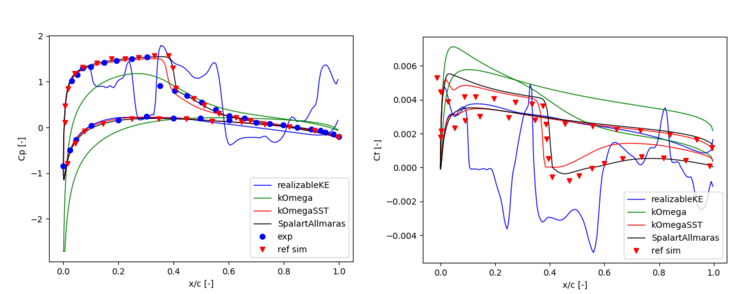NACA0012 turbulence model variation by Michael Alletto
- contributor: Michael Alletto
- affiliation: WRD MS
- contact: click here for email address
- OpenFOAM versions: v2112
- Published under: CC BY-NC-ND license (creative commons licenses)
Go back to NACA0012 tutorial page.
NACA0012 Turbulence models
Files can be downloaded here.
Turbulence model variation
As shown by various authors (see e.g. [1-3] just to cite a few) the turbulence model has a non negligible influence on the strength and the position of the shock on the airfoil surface. It is therefore important to find the turbulence model which gives the best results for the chosen setup. In this section we will compare the Spalart-Allmaras (labeled as SpalartAllmaras), the realizable k-epsilon (labeled as realizableKE), the k-omega (labeled as kOmega) and the k-omega SST model (labeled as kOmegaSST) regarding their performance in predict the strength and the location of the shock wave on the upper surface of the current test case. The figure below shows the comparison of these models with the reference experiments and simulation in predicting the distribution of the pressure coefficient (left) and friction coefficient (right). The first observation which can be made, is that for the realizable k-epsilon model no converged result could be obtained. Furthermore it can be seen that the k-omega model is too diffusive leading to a very weak shock. The steepest pressure gradient is predicted by the Spalart-Allmaras model. This model is also the only one predicting a weak shock induced separation bubble (see the plotted friction coefficient). The strength of the shock predicted by the k-omega SST model is a bit weaker compared to the Spalart-Allmaras model but the location is a bit further upstream in better agreement with the experiments.
The Spalart-Allmaras and the k-omega SST model gave similar results in regarding of the shock position. The Spalart-Allmaras model however predicted a small shock induced recirculation bubble in close agreement with the reference simulation. It is also known to be more robust and the computational demand is a bit lower compared to the k-omega SST model. For this reason it chosen for the further evaluations.
References
[1] G Barakos and Dimitris Drikakis. Numerical simulation of transonic buffet flows using various turbulence closures. International Journal of Heat and Fluid Flow, 21(5):620-626, 2000.
[2] Enda Dimitri Vieira Bigarella and Jo~ao Luiz F Azevedo. Advanced eddyviscosity and reynolds-stress turbulence model simluations of aerospace applications. AIAA journal, 45(10):2369-2390, 2007.
[3] Pietro Catalano and Marcello Amato. An evaluation of rans turbulence modelling for aerodynamic applications. Aerospace science and Technology, 7(7):493-509, 2003.
